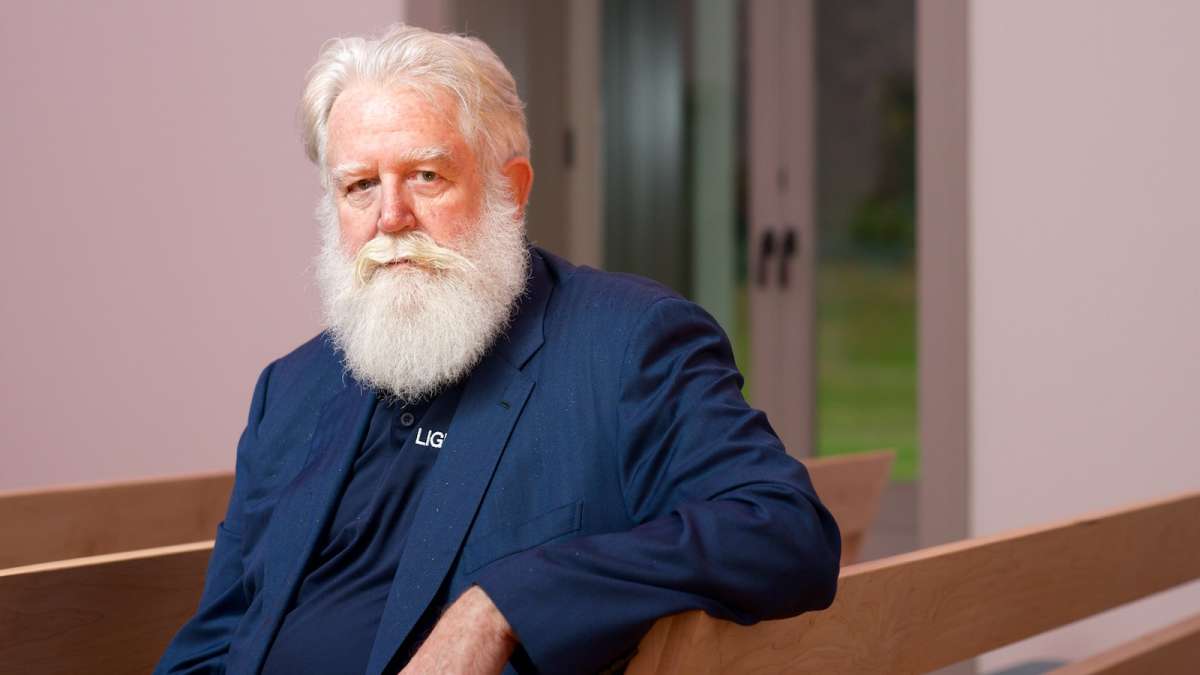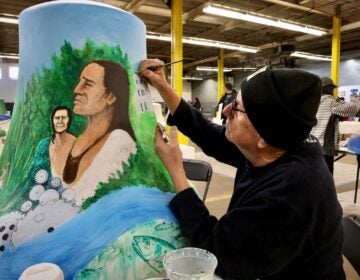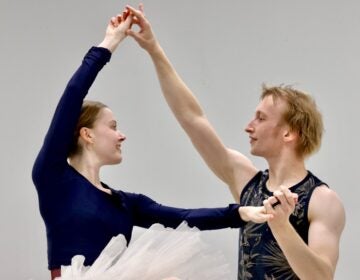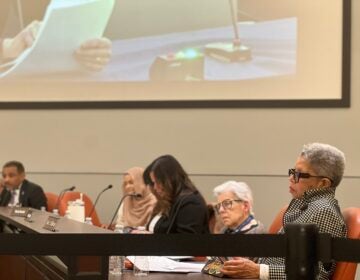Turrell Skyspace, pairing light and space, set to open to the public
Listen
Artist James Turrell in the meeting room of the Chestnut Hill Friends Meeting House. (Bas Slabbers/for NewsWorks)
The decision by a small group of Philadelphia Quakers to incorporate a James Turrell Skyspace light installation in the design of their new meetinghouse harks back to a tradition of pairing religion with art and architecture.
“Greeting the Light” is Turrell’s 76th Skyspace and the second to be located within a Quaker meetinghouse. The installation, located at the Chestnut Hill Friends Meeting, will open to the public beginning Oct. 20.
The 70-year-old, world-renown artist is larger than life. He is owner of an extinct volcano — yes, a real-life volcano — that he has spent the last 34 years transforming into a monumental work of art. And now, a Quaker himself, Turrell is hoping to help raise the status of a modest religious community.
Greeting the Light
It takes about one minute and 45 seconds for the Skyspace’s roof to retract, exposing the meeting room to the sky above and the elements. A programmed sequence of LED lighting along the perimeter of a vaulted ceiling alters the colors perceived through the rectangular opening with its vanishing edges. The interior light display works in concert with the twilight to enhance the perception of the sky and its spatial relationship to the viewer.
The entire program lasts for about an hour, taking place in what Turrell refers to as the “bardo,” or transitional state of time, at the cusp of both dawn and dusk.
Turrell’s interest in light is a testament to just how deeply his Quaker roots and faith have informed his art. This Skyspace’s title is a direct reference to his grandmother’s instructions to “go in and greet the Light” back when Turrell attended Meeting in his youth.
The psychology of perception and the viewer having an active part in creating that which is beheld is another core component of his work.
Turrell sees his Skyspaces as a visual ministry of Quaker values, deriving its power by working in silence.
Yet the self-effacing artist said he does not regard his installations at meetinghouses to be something akin to a modern Quaker missionary, only a structure that creates a sense of place.
“If it also helps to make meetinghouses again and reinvigorate programs, I’m for it. You know, I’ll do it.” he said.
Building in the Light
CHFM’s new home is the first new Quaker meetinghouse to be built in the Philadelphia region — the birthplace of American Quakerism — in more than 80 years.
The idea of incorporating a Skyspace into the new meetinghouse design came about simply because CHFM could not otherwise afford to build what they needed, explained Jon Landau, co-chair of CHFM’s committee on the new space.
By including a Skyspace similar to one that exists in Houston (the only other meetinghouse that has a Skyspace), CHFM felt that they would be able to raise funds outside of their own community and, in return, be able to offer something to a broader community, Landau explained.
With a total project budget of over six million dollars, CHFM’s goal was to raise half of their three million dollar capital campaign from within the Meeting and an equal amount from outside donors. They were successful, garnering significant grants from The National Endowment for the Arts, the William Penn Foundation and the John S. and James L. Knight Foundation.
Turrell gifted the design of his latest Skyspace as well as numerous hours of his time to the Meeting. “I make enough off of other willing victims for art, so I don’t need to bill the Quakers for this,” he said.
Landau also noted that CHFM wanted to use the Skyspace as a tool for public outreach. Members were worried that visitors to Philadelphia see Quakerism only in a historical sense and not as a living religion. The Meeting wanted to appeal to a younger generation and show people it is “very much a part of now,” he said.
The new building is twice as large as the old meetinghouse. It not only provides ample space for its nearly 200 members and attenders (non-official members who regularly come to worship), but also for a variety of social programs.
“We couldn’t have done it without the Skyspace,” Landau said.
Turrell, however, has a more humble view of art’s function. “It’s a little leavening, so it doesn’t take too much yeast to kick things off. And you never know where it extends.”
The fine art of consensus
Making CHFM’s new meetinghouse a reality was a 10-year journey of deliberations. “Quaker consensus can raise procrastination to a high art,” Turrell joked.
To facilitate the process, architect James Bradberry led the design charette — a collaborative planning dialogue — for each room. At times, there were compromises that had to be made between the Friends, the artist and the architect.
One involved the size of the meeting room and Skyspace. Turrell noted that he had originally wanted to create a larger installation, but CHFM believed it was important to keep the space intimate. The building’s fireplace was another concern. A Quaker meetinghouse traditionally has a wood burning fireplace within the meeting room.
“I made it so I had this place in there that accommodated what I kind of wanted to achieve and that was not too difficult,” Turrell said.
Building more light
The artist is currently in talks with the Detroit Friends Meeting to create another new Quaker meetinghouse with its own Skyspace. Landau says CHFM will likely be involved in the process. The “Houston [Meeting] was a big help to us. We would like to do the same thing for Detroit,” he said.
Turrell said the Quaker faithful have a large mission to accomplish, one in which he feels he has a only minor role.
“I have all hopes for the [Chestnut Hill Friends] Meeting — that it holds together and that it’s vital in people’s lives. If the Skyspace was any impetus for helping to start the construction and to do it, I’m happy for that. But it’s a small part of it.”
James Turrell’s “Greeting the Light” will open to the public, free of charge, beginning Oct. 20. Viewings will take place daily at sunrise and sunset . Sunrise viewings (commencing 50 minutes before dawn) will be held on Tuesday and Thursday mornings and sunset viewings (starting at sunset) on Tuesday and Sunday evenings. A special sunrise viewing will take place on Thanksgiving Day. Visitors are encouraged to arrive 15 to 20 minutes early and to bring their own mats, if desired. For more information (and reservations) visit the Skyspace’s website.
WHYY is your source for fact-based, in-depth journalism and information. As a nonprofit organization, we rely on financial support from readers like you. Please give today.





